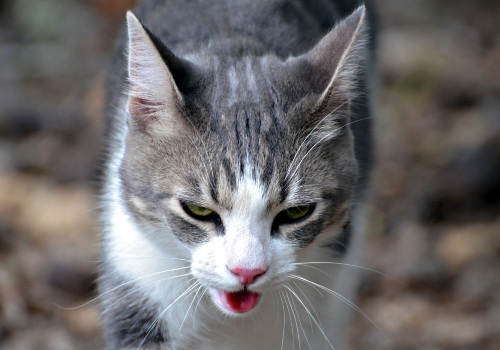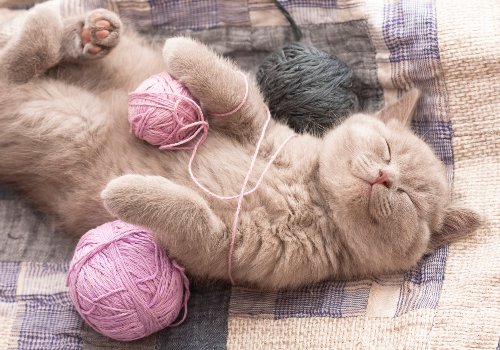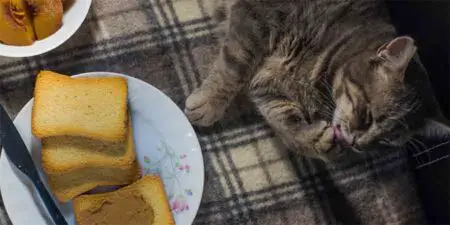Cats have a unique genetic makeup that gives pause to the use of aromatherapy around them. Because of this, we researched the toxicity of essential oils to cats.
What we found was a lot of contradictory information, with some sources claiming that all essential oils are toxic to cats.
Yet some sources suggest that if you take the proper precautions, all essential oils are safe for use around cats — and that some may even have health benefits for felines.
The truth lies somewhere in between these two extremes. That’s why, if you’re a cat owner who enjoys essential oils, it’s important to do your research before breaking out the diffuser.
Let’s take a closer look at the effects of essential oils on cats and find out how to use them safely around your furry friends.
Your Cat and Essential Oils – Sensitivity in the Nose

Compared to humans, cats have a heightened sensitivity to scents and smells. A 2017 Applied Animal Behavior Science research article revealed that a cat’s sense of smell is approximately 14 times stronger than a human’s.
200 million scent cells are found in a cat’s nose — a considerable difference from the 5 million scent cells in a human‘s nose.
In other words, if you can smell something, your cat can really smell it!
It’s not just the nose, either: cats have scent glands located on the forehead, chin, lips, tail, and front paws. They also have the Jacobson’s organ (an additional organ that processes smells) in the upper part of the mouth.
But the true secret behind a cat’s incredible sense of smell can only be revealed on a microscopic level.
Research reveals that all mammals possess three specific proteins located in the nose that function as scent receptors. One such protein, identified as V1R, enables a mammal to distinguish separate scents in a compound.
Humans possess two variations of the V1R protein, while dogs possess nine variations. But cats possess a whopping 30 variations — that means they’re 15 times better than us at breaking down a smell into individual components.
What this reveals is that a cat’s sense of smell is far superior to that of most other mammals. That’s great for feral cats who roam, track, and hunt, but it’s a potential source of trouble for housecats who are exposed to essential oils.
Your Cat and Essential Oils – Sensitivity in the Liver
There is a lot of contradictory information concerning the use of essential oils around cats. And in many cases, medical knowledge and practical experience seem at odds with each other.
First, let’s take a look at the medical side of things — specifically, the liver.
In all mammals, the liver is designed to remove the build-up of toxins from the body. Various enzymes in the liver break down and remove different varieties of toxins.
And that means that if an animal is lacking a particular enzyme, it won’t be able to remove the associated toxins.
Unfortunately, cats lack many of these enzymes, including one called glucuronyltransferase. This enzyme is responsible for ridding the body of excess carbolic acid, a type of phenol.
Phenols are a byproduct of plant metabolism and are found in many essential oils. But because cats lack the appropriate enzyme to remove them, phenols can build up in the body, resulting in liver toxicity.
Other compounds found in essential oils can also be toxic. In particular, ketones and terpenes are potential sources of danger when using essential oils around cats.
But at the same time, some research suggests that these same compounds could have health benefits for many cats.
Safe use of essential oils around cats requires solid knowledge about these compounds and familiarity with their presence in various oils. Let’s take a closer look.
12 Signs of Cat Toxicity to Essential Oils

- Apprehension
- Arrhythmia / Abnormal Heart Rhythm
- Ataxia (Loss of Balance or Coordination)
- Drooling
- Hyperactivity
- Darkened Mucous Membrane (Mouth, Nose, Tongue)
- Muscle Tremors
- Panting
- Restlessness
- Shock
- Green or Black Urine
- Vomiting
Essential Oils That Contain Phenols, Terpenes & Ketones
What Essential Oils Contain Phenols?
Research suggests phenols can effectively destroy most viruses, fungi, and bacteria. These beneficial antiseptic and antimicrobial properties are believed to boost the immune system, so many cat owners use high-phenol essential oils as a preventative health measure.
And some essential oils contain special phenols like thymol or eugenol, which are toxic to flea larvae and other parasites. Some natural pet shampoos contain eugenol and/or thymol for this reason.
But as we’ve already learned, cats simply can’t process high levels of phenols. If too many phenols build up in a cat’s body, he could quickly become very sick.
That’s why taking extra precautions when using phenol-rich essential oils is so important. Essential oils with a high level of phenols are as follows:
- Anise
- Basil (eugenol)
- Bay Laurel (eugenol)
- Birch
- Cassia
- Cinnamon (eugenol)
- Citronella
- Clove (eugenol)
- Eucalyptus
- Marjoram
- Mountain savory (thymol)
- Nutmeg
- Oregano
- Parsley
- Peppermint
- Tea tree
- Thyme (thymol)
- Wintergreen
- Ylang ylang
What Essential Oils Contain Terpenes?

Terpenes have great antiseptic properties and are responsible for many enticing aromas of essential oils. And some research suggests that essential oils containing terpenes have positive effects on respiratory tract infections, arthritis, lymphatic systems, and skin parasites.
One of the most common terpenes is pinene, which is found in pine essential oil and many others. Pinene comes in two forms: alpha-pinene (which smells earthy and fresh) and beta-pinene (which is spicier and woodier).
My cats always roll in the pine mulch and resin in the spring, summer, and fall, possibly self-medicating against fleas. They’ve never shown any ill effects from this behavior, but pinene is much more concentrated in essential oils than it is in pine mulch.
Cats can’t handle high concentrations of pinene, and buildup can result in liver toxicity, as it does with phenols. Additionally, pinene is prone to oxidizing, which can result in irritation of the skin and respiratory tract.
The following essential oils contain high concentrations of pinene. Be very careful with these oils and consider using ones that contain less pinene instead.
- Cypress (alpha)
- Dill (beta)
- Eucalyptus (alpha)
- Fir (alpha)
- Juniper (alpha)
- Myrtle (alpha)
- Nutmeg (beta)
- Pine (alpha)
- Rosemary (beta)
- Spruce (alpha)
Cats also have difficulty metabolizing d-limonene, a terpene found in many citrus essential oils. Though it can have energizing and anti-cancer effects in low concentrations, it’s toxic in higher concentrations.
These essential oils contain high amounts of d-limonene and should be highly diluted (or avoided altogether) if you have cats.
- Bergamot
- Black Pepper
- Celery Seed
- Dill
- Grapefruit
- Lemon
- Lime
- Mandarin
- Spearmint
- Sweet Orange
What Essential Oils Contain Ketones?
Ketones have calming and analgesic properties that promote cell regeneration, decongestion, and nerve health. These benefits lead many cat owners to believe they’re safe and even healthy.
But cats are much more sensitive to ketones than humans are. Felines just can’t metabolize ketones quickly enough to prevent toxic levels from building up in their bodies.
Essential oils that contain high levels of ketones can be found in the following list. To mitigate harm, dilute or avoid these oils if you have cats.
- Blue Tansy
- Cedar
- Davana
- Dill
- Fennel
- Hyssop
- Jasmine
- Marigold
- Myrrh
- Peppermint
- Rosemary
- Sage
- Spearmint
- Thuja
- Vetiver
- Yarrow
What Essential Oils Are Safe for Cats?

So do these long lists of toxic oils mean you should never use any essential oils around cats?
Well, not quite. You’ll need to be much more cautious than you would if you didn’t have cats, but if you do your research and dilute your oils properly, many can be used safely.
High concentrations of essential oils will harm any mammal, including humans. The key, then, is to dilute and diffuse small quantities to ensure relatively harmless levels of concentration for your cat.
If an essential oil contains phenols, then be sure that the oil is diluted to less than an 8 percent concentration level. The same goes for other toxic compounds: dilute to 20 percent for ketones, 15 percent for d-limonene, and 15 percent for pinene.
And use even more caution with the following essential oils, which should be diluted down to 5 percent concentration before use:
- Basil
- Cinnamon
- Clove
- Cypress
- Marjoram
- Oregano
- Peppermint
- Thyme
- Wintergreen
Diffusing Is the Safest Form of Dispensing Essential Oils Around Cats
The way you use essential oils around your cat is just as important as the type of oil.
Never apply essential oil directly to your cat’s skin, even if diluted, as it can cause severe irritation. And don’t allow your cat to ingest any essential oils, either — internal irritation is even worse than external irritation.
A diffuser is the way to go if you’re set on using essential oils around your cat.
Diffusing essential oils is the safest form of dispensing essential oils around cats for many reasons:
- Diffusion allows the dilution of the essential oil
- Diffusion promotes an environment that is anti-fungal, antiviral, and antiparasitic
- Diffusion allows ventilation in the room
- Diffusion allows your cat to leave the room if intolerant to the scent
If you are new to diffusing essential oils with your cat, then start off by choosing essential oils that have already been tested and are known to be safe around cats. These include lavender, frankincense, copaiba, and helichrysum oils.
Cats, like all animals, have their own individual preferences. So when starting a diffuser method or essential oil not already tested with your cat, stay vigilant and watch your cat’s reaction.
If the oil is bothering your cat, he may leave the room, act irritable or appear fearful. But even if he doesn’t seem bothered, it’s still important to take all possible precautions and watch for toxicity symptoms — cats don’t always know what’s best for them.
And if you see him grimacing, that doesn’t necessarily indicate an aversion! Your cat is probably just taking the scent into Jacobson’s organ, which is in his mouth.
How to Diffuse Essential Oils Around Cats
Diffusion is the safest and most tolerated form of dispensing essential oils around cats.
Add 3 to 5 drops of essential oils in a diffuser, ensuring you don’t exceed the dilution guidelines discussed earlier in this article. The diffuser can then be turned on for short periods of time until there is apparent tolerance by the cat (see this video).
When it is apparent that your cat tolerates an essential oil, then greater concentrations and periods of diffusion can be increased. Never exceed the recommended concentrations for oils containing phenols, ketones, pinene, or d-limonene.
To minimize risk, diffuse only one essential oil at a time until tolerance is established. Make sure that the room is well-ventilated and that the cat has access to an exit, in case the aroma becomes overwhelming.
21 of Our Favorite Essential Oils for Cats
- Balsam Fir
- Blue Tansy
- Cedarwood
- Clary Sage
- Copaiba
- Elemi
- Frankincense
- Geranium
- Helichrysum
- Lemon
- Lemongrass
- Melrose
- Mountain Savory
- Myrrh
- Ocotea
- Palo Santo
- Pine
- Roman Chamomile
- Rosemary
- Valerian
- Vetiver
Essential Oils for Cat Health
- Anxiety – Geranium, Lavender, Roman Chamomile, and Valerian
- Arthritis – Copaiba, Pine, Spruce and Wintergreen
- Bleeding – Cistus, Geranium, and Helichrysum
- Bones – Lemongrass, Spruce, and Wintergreen
- Calming – Lavender (all animals typically respond favorably to the smell of lavender)
- Coat Health – Rosemary and Sandalwood
- Fleas & Parasites – Eucalyptus, Lemongrass, and Tea Tree oil in very low concentrations (no more than 1%)
- Inflammation – Pine, Spruce, and Wintergreen
- Insect repellent – Blue Tansy, Eucalyptus, and Palo Santo
- Ligament/Tendons – Lavender, Lemongrass, and Palo Santo
- Pain – Clove and Helichrysum
- Sinus – Eucalyptus, Myrtle, and Pine
- Skin Cancer/Skin Ruptures – Clove, Frankincense, Geranium, Lavender, Melrose, and Myrrh
- Ticks – Cinnamon and Peppermint
- Trauma – Lavender, Melissa, Roman Chamomile, and Valerian
- Tumors/Cancer – Clove, Frankincense, Lavender, and Ledum
- Worms and Parasites – Anise, Fennel, Ginger, Juniper, Lemongrass, and Patchouli
- Wounds – Helichrysum and Melrose
Conclusion
Research reveals that cats love scent, including many of the aromas found in essential oils. And when used properly and responsibly, essential oils may have health benefits for both you and your feline friends.
A common sense approach is critical when introducing any new essential oil or aromatherapy for your cat. Research the compounds found in your oils of choice and dilute them appropriately before using them around your cat.
To be extra safe, we recommend consulting your veterinarian before using a new essential oil around your cat. Your vet can test your cat’s blood and urine to establish baseline levels, which will help identify toxicity should your cat become ill.
Additionally, vets have access to medical literature and research tools that can help establish any essential oil’s safety.
And if there’s any doubt about whether an oil is safe to diffuse around your cat, err on the side of caution. The potential benefits aren’t worth the risk to your cat’s health, so stick with known safe oils whenever possible.
Related Questions
1. Are there any essential oils that are completely safe for cats?
There is no definitive list of essential oils that are entirely safe for cats, as felines have their own individual preferences and tolerances. Some essential oils that have been tested and considered generally safe for cats include lavender, frankincense, copaiba, and helichrysum. However, diluting essential oils and monitoring your cat’s reaction when introducing new oils is crucial.
2. Can essential oils be used to repel fleas and other parasites on cats?
Some essential oils can help repel fleas and other parasites when used in low concentrations. Examples of such oils include eucalyptus, lemongrass, and tea tree oil. It’s essential to use these oils in concentrations no higher than 1% to avoid causing harm to your cat.
3. Can essential oils help with anxiety in cats?
Certain essential oils have been known to help with anxiety in cats when used responsibly. Geranium, lavender, Roman chamomile, and valerian are some essential oils that can help calm anxious cats. Always monitor your cat’s reaction and consult a vet before introducing new essential oils for anxiety relief.
4. What should I do if my cat shows signs of toxicity from essential oils?
If your cat shows signs of toxicity from essential oils, such as drooling, restlessness, vomiting, or muscle tremors, seeking immediate veterinary attention is essential. Your vet may need to run tests on your cat’s blood and urine to establish baseline levels and identify the toxic element. They will recommend the appropriate treatment for your cat based on their findings.
5. How can I safely diffuse essential oils around my cat?
To safely diffuse essential oils around your cat, use a diffuser and add 3 to 5 drops of essential oils to it, ensuring that you don’t exceed the recommended dilution guidelines. Start by diffusing the oils for short periods and gradually increase the duration once your cat shows tolerance. Make sure the room is well-ventilated and provide your cat with an exit in case the aroma becomes overwhelming.
Thank you for reading , Also checkout our new website :- www.pup.ae
"In ancient times cats were worshipped as gods; they have not forgotten this."
-- Terry Pratchett






I was just reading that tea tree oil can be toxic to cats. But, here it says it is safe?
Years ago I didn’t know TTO was considered toxic to cats, yet have been using for years to treat gunky eyes with never an issue. The article didn’t say safe, it said safe when not in excess and further said using very diluted oils and to consult your veterinarian if you had and concerns for your specific cat.
Finally, a comprehensive article about cat safe essential oils. Thank you so much! I have wondered if the hype about not using essential oils around cats was totally true. I grew up with cats, and my Mom used all kinds of scented oils, and burned incense almost all day long. Plus, she cleaned with bleach, Pine Sol, and other highly toxic chemicals, and the cats were fine. She rubbed Metholatum on my chest, and put eucalyptus oil in a humidifier when I was sick…and I always slept with my cats. Your article makes sense to me, and that video of the kitty basking in the diffuser steam was rather convincing, too.
Curious about something. I have a young cat that whenever I spray rosemary and eucalyptus water in my shower or on a washcloth, she just rolls all over the wash cloth and just goes crazy for it. She will even roll around in the tub when it is a little damp with the rosemary and eucalyptus water mixture. Is this safe for her. She acts like it is the best thing that has ever happened to her when she is rolling on the washcloth or the bathtub. Thank you.
I see everywhere that Palo Santo is toxic to cats. I am not using oil, I only burn it occasionally for a short period and they are typically out of the area but seem to be attracted to the smell so I was worried that it could be harming them.
What essential oil can I use to discourage my cats from peeing inside the house without risking their health? I can dilute it and put it in a spray bottle.
Thank you!